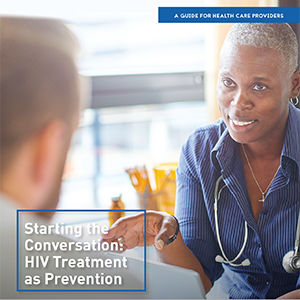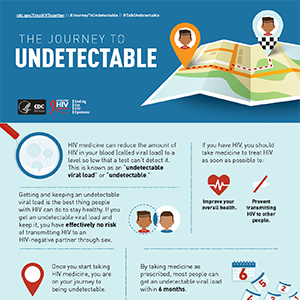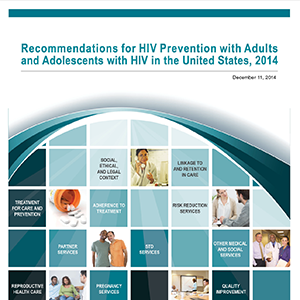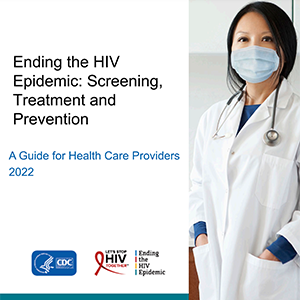How Do I Keep Patients with HIV in Care?
- Reduce barriers to HIV care for your patients.
- Build positive relationships with your patients to retain them in care.
- Engage in brief conversations with your patients at every office visit.
Sustained, regular HIV care, including initiating and maintaining antiretroviral therapy (ART), is vital to the overall health of patients with HIV and to prevent HIV transmission.
Of the estimated 1.2 million people with HIV in the United States in 2019, about 66% received HIV medical care, 50% were retained in care, and 56.8% were virally suppressed or undetectable.1
Keeping your patients in regular care improves their health and reduces their risk of transmitting HIV to others. The benefits of ongoing, regularly scheduled care can include addressing and supporting ART adherence, maintaining decreased viral load and increased CD4 count, lowering rates of progression to the most advanced stage of HIV, decreasing rates of hospitalization, and improving overall health.2-4
Poor retention in HIV care is more common in people who have substance use disorders; serious mental health problems; unmet socioeconomic needs, such as housing, food, or transportation; limited financial resources or health insurance; or schedules that complicate adherence to HIV medication.
There are several ways you can help your patients stay in HIV care, improve their medication adherence, achieve viral suppression, and improve their health outcomes, as described in the table below.
- Clinic-wide marketing(such as posters and brochures) and support (such as customer service training for patient‑facing staff) to promote attending scheduled visits and provide your patients with a welcoming and courteous experience.5,6
- “Data to Care” approachesthat use clinic and public health data to identify patients in need of retention, re‑engagement, or adherence support services to improve their health outcomes, including achieving viral suppression.7-9
- Retention and re-engagement supportfor out-of-care people or patients at risk of falling out of care (such as patients who missed a care visit or are experiencing barriers to care engagement).
- A patient navigatorto focus on retention, adherence, and re‑engagement efforts. The patient navigator can help with appointments, referrals, system navigation, service coordination, and transportation6.
- Medication adherence supportfor patients in care. Encourage your patients to download apps that help with appointment and medication reminders.
- Local or state health departments or local community-based organizationscan help providers and HIV medical clinics by integrating their existing prevention services within the HIV care clinic to provide the support services your patients need to improve engagement in and adherence to HIV care.
Establishing patient trust is key to retention in care. Studies have found that low trust in health care providers and poor provider–patient relationships are associated with lower retention in HIV care and lower satisfaction with the clinic experience.10-12 These findings underscore the need for providers to build supportive relationships with their patients to help improve their health outcomes. Below are some ways you can build a positive provider–patient relationship.
Talking with your patients at each office visit allows you to reinforce positive behaviors, uncover their barriers to successful long-term treatment, and facilitate their access to services and resources as their needs change over time—all of which contributes to strengthening the provider–patient relationship and building trust. Review the suggestions in the image below to help you start the conversation with your patients.
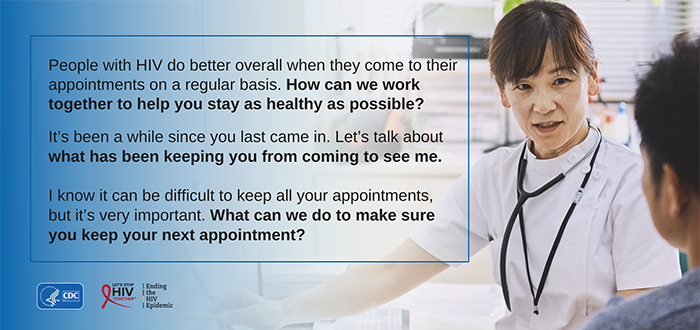
1 Centers for Disease Control and Prevention. Monitoring selected national HIV prevention and care objectives by using HIV surveillance data: United States and 6 dependent areas, 2019. HIV Surveillance Report: Supplemental Report. 2021;26(2). https://www.cdc.gov/hiv/pdf/library/reports/surveillance/cdc-hiv-surveillance-report-vol-26-no-2.pdf
2 Tripathi A, Youmans E, Gibson JJ, Duffus WA. The impact of retention in early HIV medical care on viro-immunological parameters and survival: a statewide study. AIDS Res Hum Retroviruses. 2011;27(7):751-758. https://www.liebertpub.com/doi/abs/10.1089/aid.2010.0268
3 Giordano TP. Retention in HIV care: what the clinician needs to know. Top Antivir Med. 2011;19(1):12-16. https://www.iasusa.org/tam/february-march-2011/
4 Mizuno Y, Zhu J, Crepaz N, et al. Receipt of HIV/STD prevention counseling by HIV-infected adults receiving medical care in the United States. AIDS. 2014;28(3):407-415. https://journals.lww.com/aidsonline/fulltext/2014/01280/receipt_of_hiv_std_prevention_counseling_by.13.aspx
5 Gardner LI, Marks G, Craw JA, et al. A low-effort, clinic-wide intervention improves attendance for HIV primary care. Clin Infect Dis. 2012;55(8):1124-1134. https://academic.oup.com/cid/article/55/8/1124/341728?login=true
6 Higa DH, Crepaz N, Mullins MM; Prevention Research Synthesis Project. Identifying best practices for increasing linkage to, retention, and re-engagement in HIV medical care: findings from a systematic review, 1996-2014. AIDS Behav. 2016;20(5):951-966. https://link.springer.com/article/10.1007/s10461-015-1204-x
7 Bove JM, Golden MR, Dhanireddy S, Harrington RD, Dombrowski JC. Outcomes of a clinic-based surveillance-informed intervention to relink patients to HIV care. J Acquir Immune Defic Syndr. 2015;70(3):262-268. https://journals.lww.com/jaids/fulltext/2015/11010/Outcomes_of_a_Clinic_Based_Surveillance_Informed.7.aspx
8 Seña AC, Donovan J, Swygard H, et al. The North Carolina HIV Bridge Counselor Program: outcomes from a statewide level intervention to link and reengage HIV- infected persons in care in the South. J Acquir Immune Defic Syndr. 2017;76(1):e7-e14. https://journals.lww.com/jaids/fulltext/2017/09010/The_North_Carolina_HIV_Bridge_Counselor_Program_.17.aspx
9 Udeagu CC, Webster TR, Bocour A, Michel P, Shepard CW. Lost or just not following up: public health effort to re-engage HIV-infected persons lost to follow-up into HIV medical care. AIDS. 2013;27(14):2271-2279. https://journals.lww.com/aidsonline/Fulltext/2013/09100/Lost_or_just_not_following_up__public_health.14.aspx
10 Flickinger TE, Saha S, Moore RD, Beach MC. Higher quality communication and relationships are associated with improved patient engagement in HIV care. J Acquir Immune Defic Syndr. 2013;63(3):362-366. https://journals.lww.com/jaids/fulltext/2013/07010/Higher_Quality_Communication_and_Relationships_Are.15.aspx
11 Dang BN, Westbrook RA, Hartman CM, Giordano TP. Retaining HIV patients in care: the role of initial patient care experiences. AIDS Behav. 2016;20(10):2477-2487. https://link.springer.com/article/10.1007/s10461-016-1340-y
12 Magnus M, Herwehe J, Murtaza-Rossini M, et al. Linking and retaining HIV patients in care: the importance of provider attitudes and behaviors. AIDS Patient Care STDs. 2013;27(5):297-303. https://www.liebertpub.com/doi/abs/10.1089/apc.2012.0423
